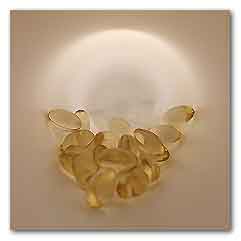|
A team of SDSU - San Diego State University
researchers found that fish oil tainted by organic
pollutants loses its cancer-fighting properties.

Fish oil, rich in healthy polyunsaturated fatty
acids, can protect against certain types of cancer,
but many types of fish are also contaminated by
waterborne toxins.
A new study by San Diego State University
researchers found that toxin-contaminated fish oil
loses much of its cancer-preventative properties.
In 2004, the U.S. Food and Drug Administration
issued a recommendation that young children and
women who are pregnant or could become pregnant
should avoid eating large amounts of fish and
shellfish.
Nearly all fish and shellfish contain mercury, which
is hazardous not only for developing children.
In recent years, the agency has expanded the warning
to note that fish also frequently contain dangerous
chemicals called polychlorinated biphenyls, or PCBs.
PCBs belong to a class of chemicals, known as
persistent organic pollutants (POPs), that break
down extremely slowly in the environment.
The U.S. government signed onto a worldwide
agreement in 2001 that banned known POPs from
manufacturing, and as a result, their levels in the
environment have dropped precipitously.
But POPs can still be found throughout the food
chain, most frequently in fish.
As bigger fish eat smaller ones, the levels of POPs
builds up in stronger concentrations.
“Large fish are now mostly the source of POP
contamination for humans,” said the new study’s lead
author, San Diego State University nutrition
professor Mee Young Hong.
A number of health risks, including reproductive,
developmental, behavioral, neurologic, endocrine,
and immunologic effects, have been linked to eating
fish with high concentrations of these toxins, but
no one has looked at how POP concentration impacts
the healthy effects of fish oil.
To find out, Hong and co-author Eunha Hoh, an
environmental health faculty member at SDSU, led a
study looking at various POP-exposure levels in
rats.
The study gave newborn rats either purified fish
adulterated with POPs (including PCBs), purified
fish oil, or corn oil as a control, then followed
their health over the next 9 weeks.
Hong, Hoh and their colleagues found that the rats
given purified, toxin-free fish oil had the lowest
number of pre-tumorous polyps.
The rats given corn oil had the most
polyps—indicating, as expected, there was no
protective effect.
But the rats given the POP-contaminated fish oil
also showed a large number of polyps, suggesting the
oil had lost much of its cancer-preventative
properties.
Even though further work will be needed before these
findings can directly translate to humans, Hoh and
Hong recommend that seafood eaters take a few
lessons to heart.
First, eat small fish whenever possible, as these
fish are lower on the food chain and will have
accumulated less POP build-up from eating smaller
contaminated fish.
Second, when buying fish oil supplements, look for
bottles that say they come from small fish, and for
a seal that states its manufacturer has removed
contaminants.
“There are no real regulations for dietary
supplements, so you as the consumer need to look at
the labels and see what kind of fish is used and
whether it’s been purified,” Hoh said.
For more information
Fish Oil Contaminated with Persistent Organic
Pollutants Induces Colonic Aberrant Crypt Foci
Formation and Reduces Antioxidant Enzyme Gene
Expression in Rats
The Journal of Nutrition
Link...
SDSU - San Diego State University
Link...
MDN |